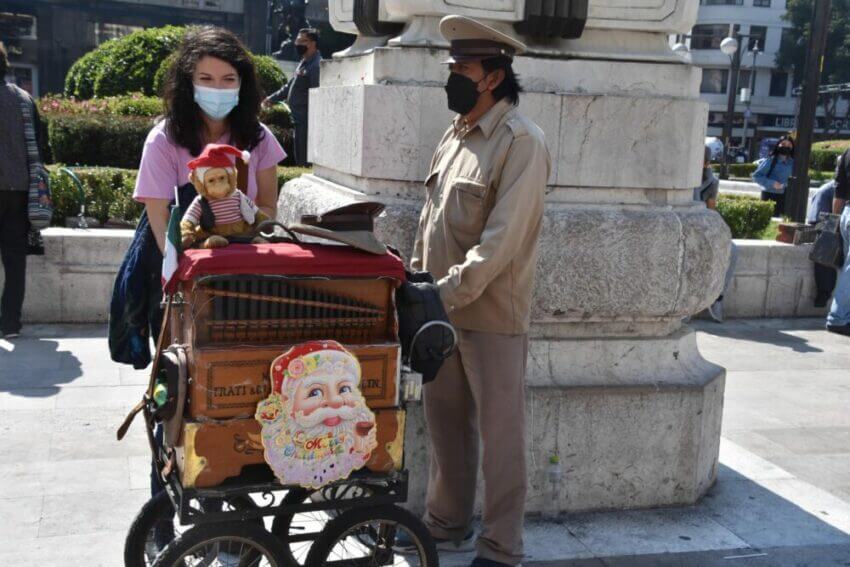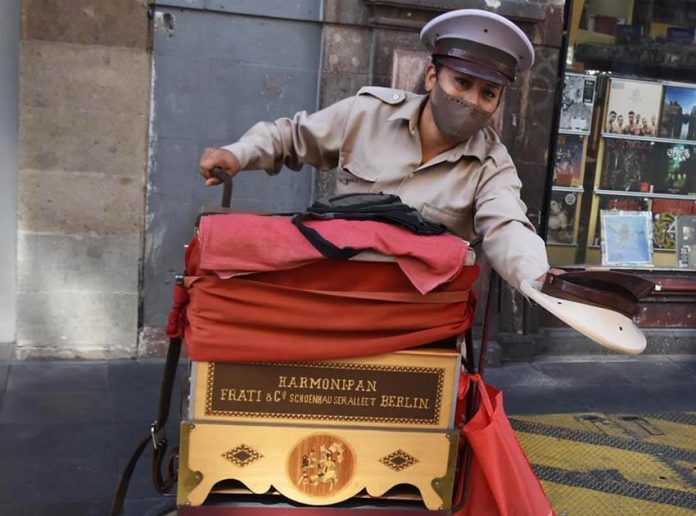Walking down the streets around Mexico City’s historic district amid all the bustle and noise, there always seems to be one sound I can hear above all the rest: the piercing music from an organillo (barrel organ). Love them (as many people do) or hate them (as many more do), they’ve been a fixture on the city’s streets for well over 100 years and will undoubtedly be around for many more.
I’ll admit that I’ve not been a fan of this musical tradition. I avoided organilleros (organ grinders) when I could and never gave them a peso when I couldn’t. I often complained to my girlfriend about the noise they made.
But one day in Mexico City, a day when organilleros seemed to be everywhere, I decided I needed to learn more about them.
Organillos were first brought to Mexico from Germany sometime in the early 1880s. The instrument consists of a box with cylinders covered by tiny metal spikes. To make music, an organillero turns a handle that’s connected to the cylinders.
As the cylinder turns, the spikes hit metal levers, each one corresponding to a specific pitch. The levers connect to rods controlling valves that let air into the instrument’s pipes, producing sound.

These days, most barrel organs in Mexico come from Guatemala or Chile.
There are around 450 organilleros in Mexico City, all dressed in a traditional uniform of a beige shirt and pants and a beige hat with a black bill. Many work in pairs, with one organillero playing the instrument while another holds out a hat, hoping to collect a few pesos.
On this day, Luís Manuel Valdovinos stood in the middle of Francisco I. Madero avenue, holding out his hat as people passed by. He comes from a family of organilleros.
His father and uncles were both in the profession. “I started working when I was 15 and have been an organillero for 33 years,” he said.
Valdovinos works with his wife Rosalba Eloisa López González and a friend, José Adán García. They’re out there six days a week, working from 9 a.m. to 6 p.m.
“I work first for necessity, second for tradition,” Valdovinos continued.
López was nearby, playing the instrument as Valdovinos collected what money he could. “It is something cultural. People like the songs,” she said. “The songs are puro Mexicano.”
Each organillo typically has eight tunes stored in the box, and organilleros change them whenever they feel like it. Although some have started playing more modern songs, the majority still play Mexican classics like “Las Mañanitas” or “Cielito Lindo.” To be honest, I’m usually not able to tell one song from another.
Organilleros generally change locations, moving from street to street every couple of hours, lugging an instrument that weighs 30 kilograms.
Although it may seem like there’s no skill involved playing an organillo, it does take some training — along with a good ear and strong arm. Songs have different tempos, and an organillero has to adjust how fast he or she turns the handle, which also must be turned consistently.
“At the end of the day, my arm is tired,” said Carlos Hernández, who’s been doing this for 15 years.
He stood patiently as a young woman tried her hand at playing the barrel organ. After a couple of cranks of the handle, she thanked him and walked away. “Many people like to try it,” he explained.
Organilleros depend on people’s generosity to earn money. “There really is no average,” said Odilón Cárdenas, who had staked out a spot in front of the Metropolitan Cathedral in the zócalo. “Some give a peso, some 10 pesos. People tend to be more generous during the Christmas season.”

Rocio Acoña and her friend Edna Romero were two of the very few people who stopped to give money. “I like it because it is a tradition,” said Acoña. “I give money to all of them.”
Romero felt the money was “symbolic” (her word). “It is not much, but it helps them survive,” she said.
The majority of organilleros are barely surviving.
“I earn about 300 pesos (US $15) a day,” said José Carmen Flores Pichardo, a 74-year-old gentleman who’s been working for 12 years.
“I work six days a week, 12 hours a day and rest on Sundays,” he said.
Although one organillero said he earned 500 pesos (USD $25) a day, three others said they usually earned about what Flores did. And they all have to pay a rental fee of 200 pesos (US $10) a day for the instrument.
The pandemic has affected these musicians perhaps more than many other workers. There are fewer tourists in the city and, with more people out of work, they’re giving less. “With the pandemic, it is hard to earn enough,” admitted Hernández.
I spent a couple of hours wandering the streets near Mexico City’s zócalo, talking to organilleros, watching them work, seeing hundreds of people pass them by as if they were invisible while they stood on the sidewalk or in the street for hours.
They held out their hats, moving from one side of the street to another with a kind of grace, never saying much more than “gracias” whether people gave them a few pesos or nothing at all.
They never accosted people and never seemed to get discouraged although they only earned a couple of hundred pesos for a 10- or 12-hour day. All the ones I spoke with said they’d continue working as organilleros.
A few had their children working with them, hoping that they would continue the tradition.
I no longer avoid organilleros and give a few pesos to each one I pass. Because before I only heard noise; now I hear music. Sweet music.
Joseph Sorrentino, a writer, photographer and author of the book San Gregorio Atlapulco: Cosmvisiones and of Stinky Island Tales: Some Stories from an Italian-American Childhood, is a regular contributor to Mexico News Daily. More examples of his photographs and links to other articles may be found at www.sorrentinophotography.com He currently lives in Chipilo, Puebla.
